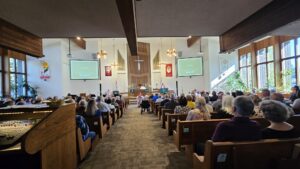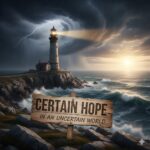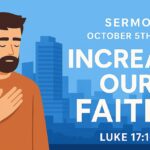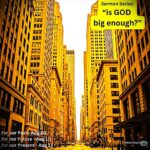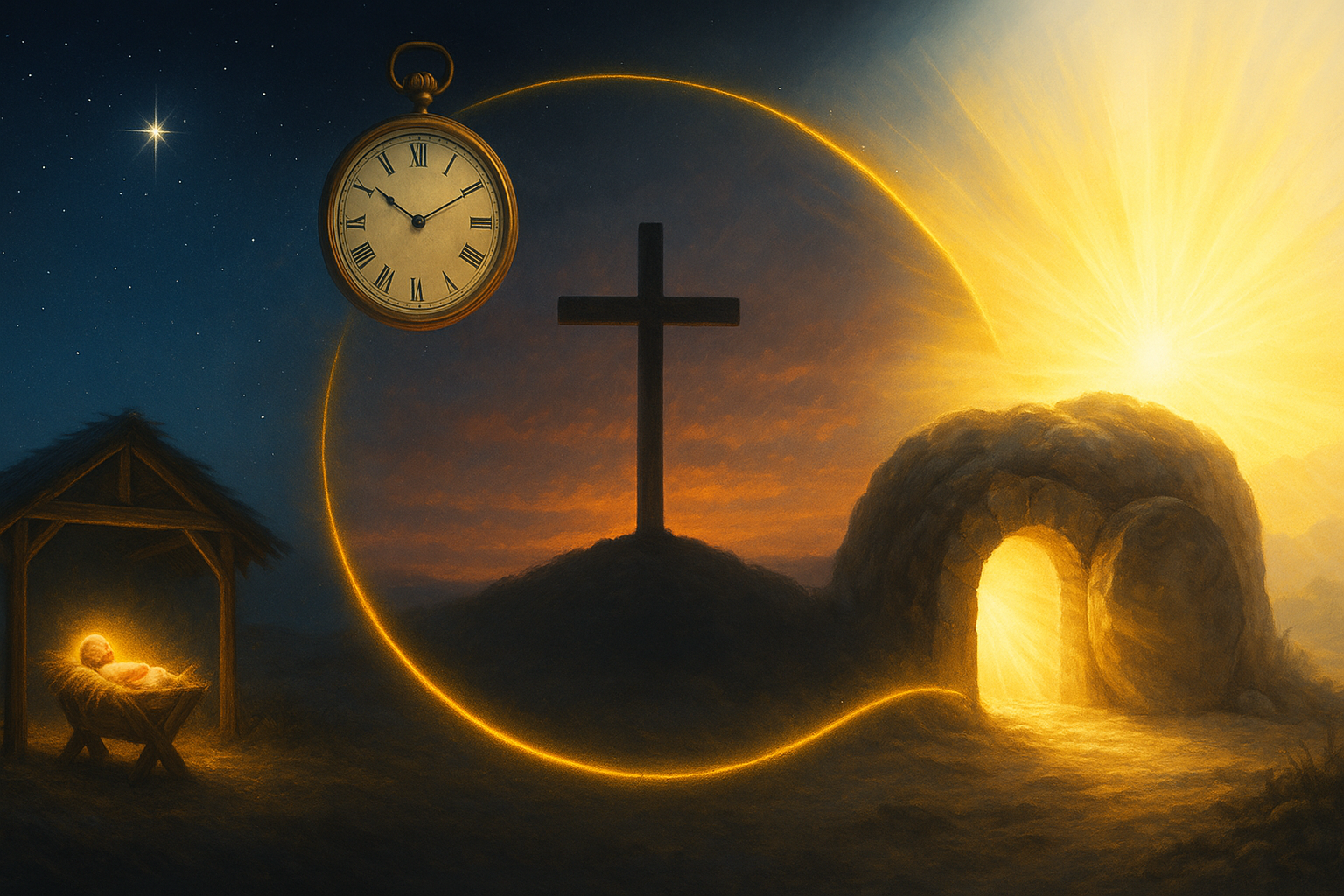
Text: John 20:1-9
Theme: “Fullness of time – Fullness of Life”
___________________________
Introduction: The fullness of life—that’s what Easter is all about. Jesus was dead, but now He is alive. He came back from the dead. He defeated death and gives us life. But there’s a connection we must never forget: this fullness of life had a beginning. It began at the fullness of time—Christmas. Let’s make that connection. Paul, could we call that up on the screen? Let’s bring Pastor Lucas from Christmas for a moment on the screen:
Video plays.
“-Hey, Pastor Lucas from Christmas—welcome to our Easter service!
-Good to be here! We just wrapped up our Christmas Eve services.
-Really? How did it go?
-It was incredible. Remember, we talked about the fullness of time—God, in His perfect timing, sending His Son, born of a woman, born under the law to redeem us, to make us children of God. We reflected on that moment when our time—chronos—intersected with God’s perfect time—kairos.
-Nice. But that’s just the beginning, right?
-Exactly. The baby born in Bethlehem came with a purpose. That’s why I’m so excited to be here and to hear as it all unfolds on this glorious Easter morning. So, take it away, Pastor Lucas and Easter.
-Thank you, Pastor Lucas from Christmas. Okay…
-Oh, before you go.
-What was that?
-You look great. Did someone lose some weight?
-That’s right. Just 15 pounds, not much, but thanks for noticing. Thank you!”
(Video ends)
Nice guy, huh? I like him.
1 – FULLNESS FULFILLED
Today we’ve come full circle. The promise was born in Bethlehem—but it is fulfilled on Good Friday and Easter morning, when Jesus dies and rises again. The story of salvation reaches its climax. From that rough manger, the baby grew into the man who gave His life for us on the cross. And this is why we gather: because Jesus didn’t stay in the tomb.
When we think about time, we can think of it in three ways.
*First, Christmas is the fullness of time.
*Then, Easter, the fulfillment in time—Jesus, at the appointed hour, enters Jerusalem, is crucified, laid in the tomb.
*Finally, Easter brings us to timelessness—because Christ is risen. And because He lives, we will rise again. Not just to live again for a while, but to live forever. One day, we will die. But on the last day, we will rise into eternal life.
So, if Christmas is the fullness of time, then Easter is the fullness of life—the fulfillment of God’s promises that we shall live forever.
The Gospel for today brings us the ingredients of the fulness of life in that early morning:
- The women go to the tomb and find it empty.
- The disciples come—and the same happens.
But here’s a detail from that morning: the disciple stooped down, saw, and believed, says the text. Believed in what? In what he didn’t see. Because he didn’t see, he believed. At Christmas, everyone was invited to go to Bethlehem and see the baby in the manger. At Easter, the disciples are called to the tomb to see the emptiness, and to believe.
At Christmas, you believe in what you see—a baby in a manger.
At Easter, you’re called to believe in what you don’t see—an empty tomb.
And that’s when it starts to click. For them, too, Jesus had been born in Bethlehem. They had walked with Him, heard His teaching, witnessed His miracles. Still, at times, they struggled to connect the dots. But Easter morning begins to change that. It’s an “a-ha!” moment. They start to see it: Christmas, Jesus’ work, His teaching, His love, the cross, the empty tomb—all part of one story.
It didn’t happen all at once. Jesus continued to appear to them, and at first they were still afraid. But over time, except for Judas, every one of the apostles embraced the message. They risked their lives to proclaim the truth—that the baby born in a manger now lives and reigns.
Sometimes we might think, “I need to see to believe.” We’d like some visible proof before we commit to the truth of something. But that’s not how life always works.
For example, you may feel joy, love, fear, or excitement. Can you prove any of that? Can you put joy under a microscope and show it to someone? No. But you know it’s real—by the signs, by what overflows from your heart, by the look in someone’s eyes, by the way people interact. You can’t see love, but you see the signs of it.
Yes, sometimes, we have to not see in order to believe. The disciples saw—and believed in what they didn’t see. That was the proof. It would still take time for them to fully grasp it. But eventually, the truth was settled: Jesus is risen from the dead. We don’t see Jesus in the way the disciples once did. But He was seen by many after the resurrection—over 500 witnesses! If it were a myth, it would’ve been easily discredited. People were alive who could’ve stood up and said, “No, this didn’t happen.”
But they didn’t—because it did happen. Jesus is not in the tomb. The disciples believed what they didn’t see. And so do we. This truth continues to shape and transform our lives. When we proclaim the risen Jesus, we may not see Him with your eyes—but the signs are all around:
- You see Jesus in His Word.
- You see Jesus in the Sacrament.
- You see Jesus in the people you help, visit, comfort, and support—just as He said in Matthew.
It’s a grand story… and it’s still unfolding in us today.
The best part? You are not talking us about feelings. We are talking about a person, the real God, Jesus and his Grand Story of love, redemption and Life. Easter is the celebration of the Fullness of Time becoming the Fullness of life. For you. For all of us.
Handel’s Hallelujah
One of the greatest geniuses who saw the beauty of this Grand Story and transformed it into music was George Frideric Handel. In his oratorio “The Messiah”, Handel begins with “Comfort, comfort my people” from Isaiah, and ends with “Worthy is the Lamb”, the song of the redeemed from Revelation.
Today we will have a small, but powerful part ot that Oratorio at the end of the Service, the “Hallelujah” Chorus. The word hallelujah comes from Hebrew. It means “praise the Lord.” It’s a plural imperative—like saying, “You all, praise Yahweh!” Yah is short for Yahweh, the personal name of God in the Old Testament. So hallelujah is a fitting expression of praise—especially on Easter morning.
You might ask, “Why Hallelujah on Easter? Isn’t that a Christmas song?” Sure, we often hear it in malls or in holiday movies. But in The Messiah, the Hallelujah Chorus bursts forth at the moment of Christ’s resurrection. That makes it entirely appropriate for Easter!
Now, there’s more about this remarkable work. Here’s some notes about the making of The Messah that may resonate with us today from the podcast “Exalting every valley” with Historian Charles King[1]
Handel’s oratorio moves from the cradle to the cross to the crown. He completed this entire composition in just 24 days[2]— composers in his time would often take a year or more. The biblical texts were assembled by Charles Jennens, who provided the scriptural backbone for Handel’s music. Here’s some important context: Handel and Jennens were on opposite sides of a very politically divided England—one was a Jacobite, the other a Hanoverian. Yet despite deep political differences, they worked together to create something profoundly beautiful, something that still brings people together centuries later – celebrated by Christians and non-Christians alike.
Maybe there’s something for us to learn in that. We have the right to have our personal political or ideological views. But when we look to the cradle, the cross, and the empty tomb—we see beyond those divisions. In faith, we know that he alone is King, and he reigns forever. We see what unites us, what forgives us, and what will remain long after all powers and ideologies fade away.
Another interesting contextual note is that at the time he composed The Messiah, Handel was not at the height of his career. He was playing something like off-broadway of the time, not anymore on top tier places so much so that they had the Hallelujah premieres in Dublin, not in London. He was largely ignored by the public, no longer performing at prestigious venues. Yet from what many thought was a low point in his career came one of the most enduring and celebrated pieces of sacred music ever written.
There’s also the story of Susanna Cibber, a renowned singer who had fallen into public disgrace. Today we might say she’d been “canceled.” But she was selected as a soloist for the Dublin premiere. Her performance was so moving that reportedly led a clergyman in the audience to exclaim, “Woman, for this be all thy sins forgiven thee!” That moment marked a turning point in her life—[3] so moving, so impactful, so redeeming for that person who fell in public disgrace, now to be back at her top game, singing such a special song. [4]
Handel did not compose background music – as I frequently overhear the Hallelujah Chorus, for example, in my kids’ videos – but solid ground music. From cradle to cross to crown, it tells the Glorious Story in music and lyrics—for the world to hear and believe.
3 – TESTIMONIES
The Easter message impacts lives. Changes lives, transforms them. You hear that a lot here. The Gospel changes lives. We often hear stories of people from the past whose lives were touched and transformed by the news of Jesus. Today we will take sometime to see how it continues to happen today, among us. I want to share with you three modern stories—real lives touched by this timeless message. Stories that lead us to raise our hands and say “Thanks be to God for His Grace and love in Jesus.”
Story 1 – The first is from Anne, a Christian who recently found renewed joy in studying the Word of God (Ann Pratt)
“This is a special day for me to reaffirm my faith in Jesus, who has been with me throughout my life according to Lutheran teaching. I’d like to say thank you to Hope for welcoming me into this family of faith, and to Pastor Lucas for your time and knowledge. It was truly enlightening and gave me a deeper understanding of the Bible, the beginnings of Christianity, and what we believe. Thanks be to God for all His blessings.”
Story 2 – The second story is from a couple who journeyed from a place of persecuted faith to one of freedom (Sep and Sam)
“Good morning, everyone. Today is the most important day of our lives. We stand before God, before our brothers and sisters in Christ, and before our own souls to declare that we are His.
We have walked many paths—some filled with light, others shadowed by doubt—but through it all, God’s love never left us. Even when we didn’t seek Him, He sought us. Even when we didn’t call His name, He whispered ours.
We grew up in a place where following Christ meant fear, silence, and uncertainty. Yet deep within, we were searching—for truth, for love, for something more than the world could offer.
Coming to Canada changed everything. We met people who lived out their faith with joy and peace. We saw something real in them—something we didn’t have, but deeply longed for.
Through the warmth of a church community, we encountered the Gospel. For the first time, we heard that Jesus died for us, loves us, and offers us new life.
That truth reached deep into our hearts and began to transform us.
Today, we leave the old behind and step into the new. We are washed not just in water, but in grace. We are not simply baptized—we are reborn in Christ.
From this day forward, our hearts belong to Jesus, our souls to God. Our lives are testimonies of His mercy and love.
To all who have guided, prayed, and walked with us—thank you.”
Story 3 –A man who realizes he was saved by God in the dark of a hospital night: (Colin)
“I grew up atheist and God was nothing more than a concept. The best way to learn about something is through personal experience, and that’s what happened to me.
In August of 2020, I was the fittest I’d ever been. I could bike 140 kilometers in a day. I could do dozens of push-ups, I was visibly fit. That would soon change. I was struck by a vehicle the following month on my bike. Things got very bad very quickly, and my body was, by all medical evidence, shutting down.
But one night in the hospital, I had a white light experience, with a voice asking me if I was ready to leave this life. And I said no.
I was discharged from the hospital in rough shape. I had a drain in my back to remove infected internal bleeding, which returned twice. I went on a double course of antibiotics, wreaked havoc on my gut, leaving me with stomach issues and food intolerances. I had nerve palsies in my eyes, and I couldn’t drive. I was diagnosed with severe PTSD. I had lost most of my muscle mass, and I was in constant pain. I could barely even shower myself, and walking to the end of the block was an endeavor. I had four specialists tell me I was lucky to be alive, and I had another four tell me that I would never return to the activities I had loved. Being unemployed while fighting to rebuild my life allowed the worst of me to come to light.
I watched from the sidelines as others moved on. New relationships, promotions, raises, vacations, moving out. I could do none of that, despite having worked harder. Envy, pride, wrath shone through. I struggled to reconcile the concept of a loving God who had offered me a second chance with a God who had inflicted such a burden on me.
I worked hard through the next several years, even to today. I’ve spent over 1,000 hours in medical appointments, physiotherapy exercises, you name it, with one value in mind, hope. The belief that with consistent work, things will get better. And I saw glimmers of it from time to time when I finished the Juan de Fuca Trail backpacking trip a few years ago with my parents. When I ran a half marathon, both things told impossible. They came with great pain that took weeks to recover from, and again, more physio. But both served as manifestations of hope.
Over the years, I’ve grown physically stronger, not to where I was, but mentally, I was still reeling. I felt a deep turmoil. I had a grateful side and a spiteful, pessimistic side that had dug in really deep.
But by a chance encounter with a Bible verse I came across on social media, I felt momentarily at peace and began introspection. After some discussions with practicing Christians, I felt the need for change.
In the final few months of 2024, I spent a significant amount of time researching various Christian sects. What I found in Lutheranism resonated in me with the Bible as the inerrant, infallible source of truth. When looking for Lutheran churches, hope stood out to me first by its name representing the same feeling that had helped me through the darkest chapter in my life. I watched Pastor Lucas’ videos on the website and they struck a deep chord within me.
On December 24th, 2024, I attended church services for the first time. I found an extremely welcoming community. Before I’d even walked inside, I had one person greet me and I had two people introduce themselves. They made it clear I was welcome. From the first service, I knew that God through Jesus was worth spending more time getting to know and that hope was the place to do it.
In the months since, the hope hospitality has not worn off. I find myself more forgiving of others and accepting, appreciative, and aware of God’s grace. I have no doubt that God saved me that night, offering me a second chance. And I’ve started seeing more of God’s presence pop up too. I stand here as a former atheist saved by the same event that should have killed me, struggling to comprehend how I got here, but I’ve come to learn that it’s the beauty of God’s plan.”
God’s word, fullness of time and fullness of life is for us. And as a Christian congregation, as a Christian community, every time we hear stories like that and many others, we know that we are witnessing Christ is risen. He is with us, walking in us and dwelling in our hearts. The fullness of time becomes the fullness of life. Jesus, born in a manger, hung on a Cross, comes out of his tomb to give life and salvation. For you. For all.
Cc – So just to go back to full circle, let me call up Pastor Lucas from Christmas again. (Video plays) Thanks for coming.
“It’s no problem. It was great to be here. It’s good to see this church full of people here celebrating Easter. Christ was born in Bethlehem, but he came with the purpose to be there on his cross and then out of his empty tomb. That’s why we usually say, Pastor Lucas, this is the season…”(video ends)
…for this is the reason: Christ is risen indeed. And He gives us fullness of life. Amen.
____________________________________
[1] Charles King, “Exalting Every Valley” in: The Bulletin podcast. Available at: https://podcasts.apple.com/us/podcast/exalting-every-valley-with-charles-king/id1653893811?i=1000679867285
Other connections:
- Messiah as Communal Witness
King emphasizes that Messiah isn’t just a soloist’s showcase—it’s a community event. From the very first performances, Handel invited the audience to stand for the “Hallelujah Chorus,” creating a shared moment of witness to Christ’s victory.- Just as the congregation stands and sings together, Easter calls us not to passive observance but to active proclamation—we become the messengers of the resurrection.
- Transcending Division Through Shared Story
He recounts how the political rifts of 18th‑century England—Handel’s royalist Hanoverian sympathies vs. Jennens’s Jacobite leanings—melted away in the rehearsal hall. Their joint labor on Messiah forged something greater than their differences.- The empty tomb unites us beyond our political, social, or personal divides. Easter’s message is that death has been defeated for all, and so we’re called to reconciliation and unity as the body of Christ.
- Scripture Sung, Not Simply Read
King highlights that Jennens’s libretto selects and arranges biblical texts not chronologically but thematically, so that prophecies, gospel narratives, and apostolic declarations flow in one cohesive, sung sermon. - Art as an Encounter with the Divine
He notes that many early listeners described feeling as if “all heaven” was present in the music.- Easter isn’t an abstract doctrine—it’s an encounter with the living Christ. We approach the empty tomb expecting to meet Him, just as audiences encountered the divine in Handel’s Messiah.
- Hope in the Midst of Despair
Finally, King reflects on how Messiah was first performed in Dublin during a time of famine and suffering. Its message of comfort and vindication offered real hope to a hurting population.- Where anxiety, grief, and division abound, Easter’s proclamation of new life speaks directly into our need for comfort and hope.
[2] George Friderich Handel composed the entire music for Messiah in just 24 days. After receiving Charles Jennens’s libretto in July 1741, Handel began work on August 22, completed Part I by August 28, Part II by September 6, and Part III by September 12, then spent two days “filling up” the score—finishing on September 14, 1741 (Wikipedia)
[3] https://www.wsj.com/arts-culture/books/every-valley-review-handels-messiah-in-the-making-8efa134b?utm_source=chatgpt.com
[4] In 1737 Handel suffered what was probably a stroke, which for a time affected the use of his right hand. Friends noted periods of mental confusion, perhaps, Mr. King writes, “a result of lead poisoning, a common danger from wig powder and fortified wines and spirits stored in leaded vessels.” Journalists and pamphleteers began to ridicule him as fat (which he was) and his music as stale (which it never was). That “Messiah” was first performed in Dublin, where Handel had been invited to give a series of concerts in the winter of 1741-42—and not in London—is itself suggestive of a waning career.”[4]
What was ridiculed in London the 18th century is acclaimed around the world ever since.
In those moments in your life in which you will feel weak, waning, decaying, remember that, as the “Messiah” changed music’s history, Jesus, The Messiah, changes your heart and your story, bringing you close to Him. https://www.wsj.com/arts-culture/books/every-valley-review-handels-messiah-in-the-making-8efa134b?utm_source=chatgpt.com

